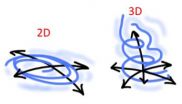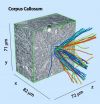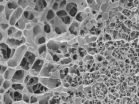(Press-News.org) Philadelphia, October 23—A new study shows that New Jersey's law requiring novice drivers to display a red decal on their license plates has prevented more than 1,600 crashes and helped police officers enforce regulations unique to new drivers. The first-in-the-nation decal provision went into effect in May 2010 as part of N.J.'s Graduated Driver Licensing (GDL) law. Nearly every state has a GDL law on the books, but "Kyleigh's Law," named for a teen driver killed in a 2006 N.J. crash, is the first one that requires drivers under age 21 to display their probationary status so that they are more visible to police.
Allison E. Curry, PhD, director of Epidemiology and Biostatistics at the Center for Injury Research and Prevention at The Children's Hospital of Philadelphia, and her colleagues compared GDL-related teen driver citations and crashes in the two years before the decal law was implemented to citations and crashes in the year following the law's implementation. (In New Jersey—as well as in many other states—new drivers are subject to GDL-specific restrictions meant to keep them as safe and distraction-free as possible while they become more seasoned drivers.) These latest results, published today in the American Journal of Preventive Medicine, showed that in its first year of implementation, the New Jersey decal provision prevented an estimated 1,600 probationary drivers from crashing. Furthermore, Curry and her colleagues found that the rate at which police issued citations to novice drivers increased 14 percent in the year after decals became required.
"Other countries have been using decals for decades, but this is the first study to rigorously evaluate their effect on crashes," says Dr. Curry. "The study shows that by taking an additional step to supplement its GDL laws, New Jersey is helping to keep its young drivers safe." At any given time, there are about 65,000 17-year-old probationary drivers on New Jersey's roads.
GDL laws are used by all U.S. states to phase young drivers into full licensure by extending the learning period and restricting them from engaging in certain behaviors that can increase their crash and resulting fatality risk. Probationary drivers can be fined $100 for not complying with one (or more) of New Jersey's GDL restrictions, which include limits on the number of passengers that can be in the car, a ban on the use of cell phones and other electronics, and a driving curfew between the hours of 11 p.m. and 5 a.m. Curry and her colleagues noted an impact of the decal law on crashes involving passengers—the rate of crashes involving peer passengers decreased by 9 percent.
"The fact that we saw significant crash reductions in New Jersey, a state that already has a strong GDL law and one of the lowest teen crash fatality rates, suggests that implementation of a decal law in states with higher teen crash fatality rates may lead to even more marked reductions," said Curry. "We hope that our study can help other states looking to reduce teen crash rates."
The researchers linked New Jersey's crash reports and licensing databases to identify novice drivers who have been involved in crashes. The reductions in crashes as a result of the decals were based on the difference between actual crashes and the estimated number of crashes that would have occurred had the decal law not been implemented.
###Curry's co-authors included colleagues Russell Localio, PhD, and Dennis R. Durbin, MD, all of Children's Hospital of Philadelphia, and Melissa R. Pfeiffer, MPH, an independent researcher. The study was funded by a grant from Public Health Law Research, a national program of the Robert Wood Johnson Foundation.
About Public Health Law Research
Public Health Law Research (PHLR) is a national program of the Robert Wood Johnson Foundation, with direction and technical assistance by Temple University. The program is dedicated to building the evidence base for laws that improve public health. PHLR funds research, improves research methods, and makes evidence more accessible to policy-makers, the media, and the public. For more information about PHLR, visit http://publichealthlawresearch.org.
About the Robert Wood Johnson Foundation
The Robert Wood Johnson Foundation focuses on the pressing health and healthcare issues facing our country. As the nation's largest philanthropy devoted exclusively to improving the health and healthcare of all Americans, the Foundation works with a diverse group of organizations and individuals to identify solutions and achieve comprehensive, meaningful, and timely change. For 40 years the Foundation has brought experience, commitment, and a rigorous, balanced approach to the problems that affect the health and healthcare of those it serves. When it comes to helping Americans lead healthier lives and get the care they need, the Foundation expects to make a difference in your lifetime. Follow the Foundation on Twitter (www.rwjf.org/twitter) or Facebook, (www.rwjf.org/facebook).
Study shows New Jersey's decal for young drivers reduced crashes
2012-10-23
ELSE PRESS RELEASES FROM THIS DATE:
Effective treatment helps Danes with personality disorders
2012-10-23
For seven years, Carsten René Jørgensen from the Department of Psychology and Behavioural Sciences at Aarhus University has collaborated with the Clinic for Personality Disorders, Aarhus University Hospital, Risskov on examining the extent to which modern psychoanalytic psychotherapy can help the Danes suffering from severe borderline personality disorders.
Among the first to examine these forms of modern psychoanalytic treatment of severe personality disorders, the study shows a clear trend; a vast majority of patients do better after a two-year course of treatment.
- ...
Improving medical research education across Europe
2012-10-23
Fostering and improving medical research education is crucial to biomedical research and clinical patient treatment, and as such it has been identified as the main challenge in every joint European Science Foundation (ESF) - European Research Medical Councils (EMRC) strategy report. A new policy report entitled "Medical Research Education in Europe" has just been published looking at crucial factors to improve medical research education throughout Europe.
The new science policy briefing report features an overview of medical researchers' training across Europe. It identifies ...
Leading European experts call for more rigorous scientific evidence for healthcare interventions
2012-10-23
Leading clinicians and health researchers from across Europe say much greater emphasis must be placed on the scientific evidence for the effectiveness of treatments and other healthcare interventions to ensure patients receive the best care available. The call is contained in a Science Policy Briefing published by the European Medical Research Councils, which also made ten key recommendations on how to improve the quality of research and healthcare in Europe.
The briefing, 'Implementation of Medical Research in Clinical Practice', says that there must be much greater ...
Biologists record increasing amounts of plastic litter in the Arctic deep sea
2012-10-23
Biologists record increasing amounts of plastic litter in the Arctic deep sea: studies confirm that twice as much marine debris is lying on the seabed today compared to ten years ago
Bremerhaven, 22nd October 2012. The seabed in the Arctic deep sea is increasingly strewn with litter and plastic waste. As reported in the advance online publication of the scientific journal Marine Pollution Bulletin by Dr. Melanie Bergmann, biologist and deep-sea expert at the Alfred Wegener Institute for Polar and Marine Research in the Helmholtz Association. The quantities of waste observed ...
Next-generation vaccines -- eliminating the use of needles
2012-10-23
Lead scientist Professor Simon Cutting, from the School of Biological Sciences at Royal Holloway, has developed the jabs through the use of probiotic spores. He carried out fundamental studies into the biology of the bacterium Bacillus subtilis which attracted the attention of microbiologists due to its ability to form spores that can last millions of years before germinating under the appropriate environmental conditions.
Professor Cutting says: "The mechanisms by which this process occurs have fascinated microbiologists for decades making it one of the most intensively ...
Turbulent flows in 2D can be calculated in new model
2012-10-23
Turbulent flows have challenged researchers for centuries. It is impossible to predict chaotic weather more than a week in advance. Wind resistance on a plane or a car cannot be calculated precisely, since it is determined by atmospheric turbulence. Now, however, researchers from the Niels Bohr Institute have succeeded in developing a statistical model that can replicate the chaotic flows and thereby provide a better understanding of the process. The research results are published in the scientific journal, Physics of Fluids.
"Without knowing the movements in detail, we ...
Quantum computing with recycled particles
2012-10-23
A research team from the University of Bristol's Centre for Quantum Photonics (CQP) have brought the reality of a quantum computer one step closer by experimentally demonstrating a technique for significantly reducing the physical resources required for quantum factoring.
The team have shown how it is possible to recycle the particles inside a quantum computer, so that quantum factoring can be achieved with only one third of the particles originally required. The research is published in the latest issue of Nature Photonics.
Using photons as the particles, the Bristol ...
A circuit diagram of the mouse brain
2012-10-23
This press release is available in German.
What happens in the brain when we see, hear, think and remember? To be able to answer questions like this, neuroscientists need information about how the millions of neurons in the brain are connected to each other. Scientists at the Max Planck Institute for Medical Research in Heidelberg have taken a crucial step towards obtaining a complete circuit diagram of the brain of the mouse, a key model organism for the neurosciences. The research group working with Winfried Denk has developed a method for preparing the whole mouse ...
Lung mucus gel scaffold prevents nanoparticles from getting through
2012-10-23
Mucus coats our airways' internal surfaces. The viscous gel humidifies the lungs and prevents viruses and other small particles like diesel soot from entering the body unchecked. Previously unclear was the extent to which such nanoparticles are able to move through the lungs' mucus. Here, the research evidence was contradictory. Scientists could not explain why, in inhaled medication development, drug nanoparticles often simply got stuck in the mucus never making it to their target destination inside the lung cells.
Now, as part of a German Research Foundation (DFG)-funded ...
The complex association between moderate alcohol consumption and breast cancer
2012-10-23
An excellent review article from two scientists at the National Institute on Alcohol Abuse and Alcoholism in the USA to be published in Alcohol Clin Exp Res 2012, describes the epidemiologic and basic scientific evidence linking alcohol consumption to the risk of breast cancer.
The authors point out deficiencies in the epidemiologic data, especially that the pattern of drinking (regular moderate versus binge drinking) has generally not been taken into consideration, important given that binge drinking is associated with much higher blood alcohol concentrations and acetaldehyde ...


